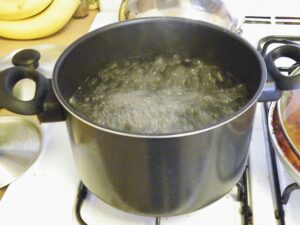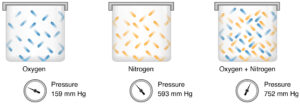In this article “Boiling point and partial pressure” is describe so broadly thus we can get a concept about boiling point and partial pressure also boiling point and partial pressure related facts are prattle here.
Boiling point for a liquid substance can be describe as temperature for a liquid substance is equal to the pressure which is applied from external and the vapor pressure. In a compound of gasses each and every gas carries the total amount of the pressure of the compound.
What is boiling point and partial pressure?
Boiling point and Partial pressure both are very important topic for any liquid substance. Partial pressure and pressure different physical parameters and boiling point is not only depends upon the temperature.
Partial pressure can be explained as in a compound of gases, the pressure which is applied externally from the surroundings of liquid substance with the help of a particular gas. The amount of temperature for a liquid substance the standard sea level pressure of atmospheric is equal to vapor pressure.
Boiling point:
The boiling point is actually the temperature of a matter at which the pressure surrounding for a liquid matter is equal to the pressure of vapour of a liquid matter for this reason liquid matter changes into vapour.
Boiling point can be explained as the molecules of a liquid matter are free, when it leads to formation of vapour bubbles within liquid matter.

Image Credit – Wikipedia Commons
Formula:
The formula of boiling point for a substance can be written as,
Where,
Kb = Boiling point of a solvent
Tb = Temperature for the boiling point in a solvent
M = Molar mass of a solvent
Δ Hv = In a liquid solvent the amount of heat in vaporized in per mole.
R = Universal gas constant
In other way the boiling point for a liquid matter is depends upon the pressure of the surroundings environment. Liquid matters can change it state of matter in vapor when the temperature is lower than its boiling point, this process identified as evaporation.
The evaporation is a very important surface subject by which the molecules present in the liquid matter easily can locate in the edges of the liquid matter and free into the surrounding environment when the liquid is vaporized as vapour.
Partial pressure:
When a jar is full with mixture of gas that times each and every gas applied pressure. The pressure of any one time of gas within the jar is known as partial pressure.
Read more about Pressure vessel : It’s important facts and 10+ applications
Pressure and partial pressure is not same. The pressure for a matter expressed as P but the partial pressure for a substance is expressed as, P1, P2

Image Credit – Wikimedia Commons
Relation between partial pressure and boiling point:
The relation between the partial pressure and boiling point of a liquid substance is dependent on the pressure of the surroundings environment of the liquid.
The relation between the partial pressure and boiling point is directly proportional to each other. Means if partial pressure of a liquid substance is increases then the amount of boiling point is also increases as well as when partial pressure decreases then the amount of boiling point is decreases.
Read more about Pressure vessel design : It’s important facts and 5 parameters
Frequent Asked Question:-
Question: What is Mole ratio?
Solution: By the help of mole ratio the fraction of a compound gas can be calculated.
Mole ratio can be explained as the ratio between partial pressure of a particular gas and total amount of pressure in a compound gas.
Formula:
The formula of partial pressure for a liquid substance can be written as,
Xi= Mole ratio
Vx= Partial pressure of a identified gas
Vi= The total amount of volume of the compound gas
Px = The partial pressure for x gas
Pi = The total amount of pressure of the compound gas
Nx = The amount of matter of the compound gas
Ni = The total amount of matter of the compound gas
This partial pressure formula is applicable for ideal gas matter.
Question: Explain Dalton’s law of partial pressure.
Solution: From the law of Dalton’s we get a clear concept about the partial pressure of a matter.
The law of Dalton of a partial pressure is explain as, the total amount of pressure is exerted by externally by a compound of gasses substance is equal to total amount of partial pressure which is exerted by each every particular gas in the compound.
Suppose in a jar two types of gas carbon monoxide and oxygen is present and makes a mixture. Then the total amount of pressure exerted in the compound gas of car monoxide and oxygen is sum is equal to their individual partial pressure which is exerted by gas car monoxide and gas oxygen.
Formula of Dalton’s law:
The formula of Dalton’s law can be written as,
Where,
Ptotal = The total amount of pressure which is exerted by the compound of gas
P1 + P2 + P3………..+Pn = Partial pressure of the compound of gas.
Question: Write some applications of boiling point which are applied in our regular lifestyle.
Solution: The boiling point is a very important factor not only in physics and chemistry it’s also useful in our daily life.
The applications of boiling point which are applied in our regular lifestyle is given below,
- Storage of chemicals
- Antifreeze
- Pressure cooker
- Sugar refining
- Molar mass measurement
- Boiling milk
- Cooking with salt
- High Altitude Cooking
- Poor Cup of tea at Mountains
Question: If impurities are present in a liquid matter then what changes is happened with boiling point?
Solution: Impurities plays a vital role in the substance of a liquid.
In the liquid matter amount of heat is applied is absorb by the impurities for this reason the inside temperature is increasing. So, if impurities are present in a liquid matter then boiling point will be increases.
Question: Which factors are affected the boiling points?
Solution: The factors which are affected the boiling points,
- Temperature
- Vapor pressure
- Atmospheric pressure
- Inter molecular bonds
- Solvent, Solution
- Impurities
Hi..I am Indrani Banerjee. I completed my bachelor’s degree in mechanical engineering. I am an enthusiastic person and I am a person who is positive about every aspect of life. I like to read Books and listen to music.